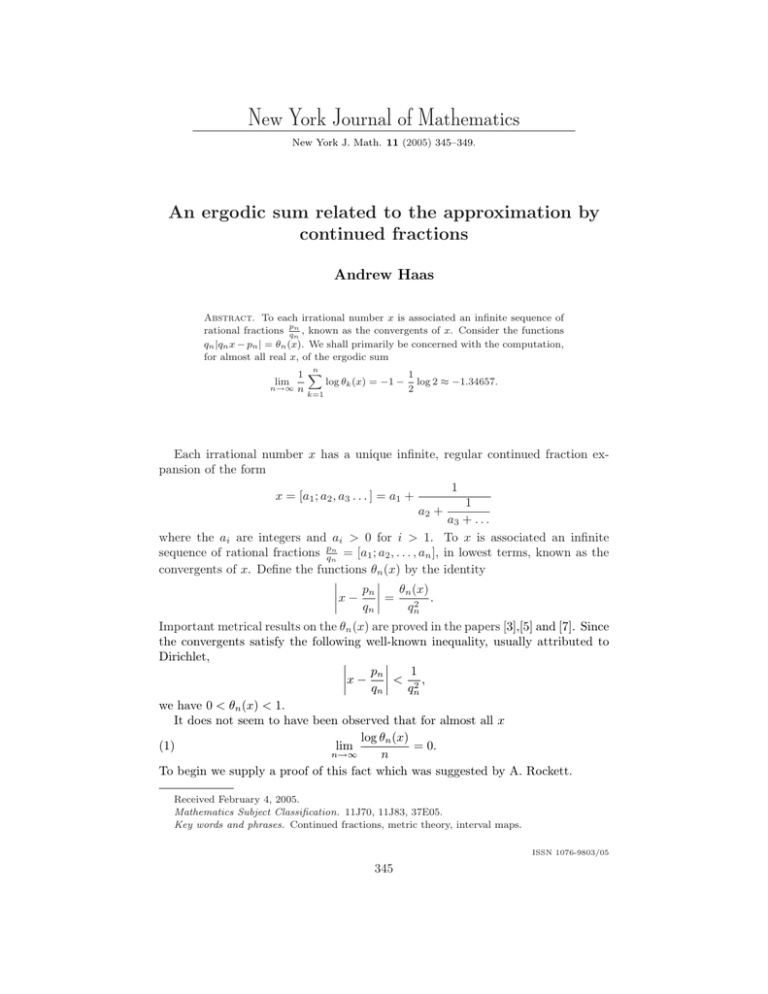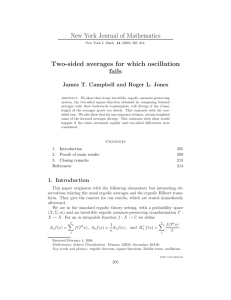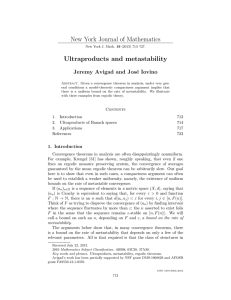New York Journal of Mathematics continued fractions Andrew Haas
advertisement

New York Journal of Mathematics New York J. Math. 11 (2005) 345–349. An ergodic sum related to the approximation by continued fractions Andrew Haas Abstract. To each irrational number x is associated an infinite sequence of rational fractions pqn , known as the convergents of x. Consider the functions n qn |qn x − pn | = θn (x). We shall primarily be concerned with the computation, for almost all real x, of the ergodic sum lim n→∞ n 1 1 log θk (x) = −1 − log 2 ≈ −1.34657. n k=1 2 Each irrational number x has a unique infinite, regular continued fraction expansion of the form 1 x = [a1 ; a2 , a3 . . . ] = a1 + 1 a2 + a3 + . . . where the ai are integers and ai > 0 for i > 1. To x is associated an infinite sequence of rational fractions pqnn = [a1 ; a2 , . . . , an ], in lowest terms, known as the convergents of x. Define the functions θn (x) by the identity x − pn = θn (x) . qn q2 n Important metrical results on the θn (x) are proved in the papers [3],[5] and [7]. Since the convergents satisfy the following well-known inequality, usually attributed to Dirichlet, x − pn < 1 , qn qn2 we have 0 < θn (x) < 1. It does not seem to have been observed that for almost all x log θn (x) lim (1) = 0. n→∞ n To begin we supply a proof of this fact which was suggested by A. Rockett. Received February 4, 2005. Mathematics Subject Classification. 11J70, 11J83, 37E05. Key words and phrases. Continued fractions, metric theory, interval maps. ISSN 1076-9803/05 345 346 Andrew Haas From the sequence of inequalities (see [9]), pn 1 1 ≤ x− ≤ qn (qn + qn+1 ) qn qn qn+1 we get 1 log n qn qn + qn+1 1 1 ≤ log θn (x) ≤ log n n qn qn+1 . The result then follows easily from the Khintchine–Lévy Theorem, which asserts that for almost all x 1 π2 , log qn = n→∞ n 12 log 2 lim (2) (see [2] or [9]). Now we look at the limiting average ofthe functions log θn (x). While this avn erage resembles those, such as limn→∞ n1 k=1 θk (x), computed in [3] and [5], its evaluation is complicated by the fact that log x is not continuous on the interval [0,1]. As a result, knowledge of the distribution function for θn (x) is not sufficient to prove the theorem. As in [3], we work with a form of the natural automorphic extension of the Gauss transform, derived from the extension originally given by Nakada [8]. Theorem 1. For almost all x n 1 1 log θk (x) = −1 − log 2 ≈ −1.34657. n→∞ n 2 lim k=1 Let Λ = ((0, 1) \ Q) × [0, 1] and define the map S : Λ → Λ by t) = S(s, 1 1 1 , − s s t + [ 1s ] where [x] is the greatest integer function. Let ν be the probability measure with density m(s, t) = log1 2 (1 + st)−2 . It was first observed by Nakada [8] that the is ergodic. See also [1]. dynamical system (Λ, B, ν, S) Consider the related self-mapping T of Ω = ((0, 1) \ Q) × [−∞, −1] defined by T(x, y) = 1 1 1 1 − , − . x x y x Let ϕ : Λ → Ω be the invertible function given by ϕ(s, t) = (s, − 1t ). It is clear that ϕ maps Λ onto Ω and that T = ϕ ◦ S ◦ ϕ−1 . An ergodic sum related to continued fractions 347 The measure μ = ϕ∗ ν is defined by 1 1 μ(D) = dsdt, log ϕ−1 (D) (1 + st)2 where D is a borel subset of Ω. It follows by an application of the chain rule that μ has the density p(x, y) = log1 2 (x − y)−2 . As constructed, μ is invariant under the action of T and ϕ defines an isomorphism between the dynamical systems and (Ω, B, μ, T). It follows that (Ω, B, μ, T) is an ergodic dynamical (Λ, B, ν, S) system. The ergodicity of T is central to the proof of Theorem 1 that follows. Let T (x) = x1 − [ x1 ] be the classical Gauss map and let π(x1 , x2 ) = x1 be projection on the first factor. Then independent of y, π ◦ T(x, y) = T (x) and π ∗ (μ) is the classical Gauss measure, which is an invariant measure for T , with density 1 g(x) = log1 2 1+x . For irrational x = [0; a1 , a2 . . . ], the Gauss map T acts as a shift on continued fraction expansions with T (x) = [0; a2 , a3 . . . ]. Even when x is rational, T acts as a shift on the finite continued fraction expansion and the iterates are defined until T n (x) = 0. We assume henceforth that x = [0; a1 , a2 . . . ] is irrational. The iterates Tn (x) are then defined for all positive integers n. If y = −[a−1 ; a−2 , . . . ] ∈ (−∞, −1], with a possibly finite continued fraction expansion and x is as above then Tn (x, y) = (x̂, ŷ) where x̂ = [0; an+1 , an+2 . . . ] and ŷ = −[an ; an−1 , an−2 , . . . , a1 , a−1 . . . ]. Define the function 1 y−x 1 − = log . F (x, y) = log x y xy We show that F is integrable on Ω = (0, 1) × (−∞, −1] with respect to the density p. It shall soon be clear that F is very useful for computing the quantity log θn (x). y−x p(x, y) dxdy log xy Ω −1 1 log y−x xy 1 = dxdy log 2 −∞ 0 (x − y)2 −1 1 + log(1 − y) − log(−y) 1 dy = log 2 −∞ y(y − 1) 1 1 lim log(−y) + log(1 − y) + (log(−y))2 = h→∞ log 2 2 −1 1 + (log(1 − y))2 − log(−y) log(1 − y) 2 −h 1 1 log 2 + (log 2)2 = log 2 2 1 1 1 1 2 log(−y) − 2 log(1 − y) + 1 2 log(1 − y) − 2 log(−y) + 1 − lim + 1 1 h→∞ log(−y) where the last limit is zero by L’Hospital’s rule. log(1−y) 348 Andrew Haas Since F is μ-integrable and Tn (x, y) is defined on a set of full measure for all n ≥ 0, it is a direct consequence of the Birkhoff Ergodic Theorem (see [4] or [2]) that for almost all (x, y) ∈ Ω n 1 i lim (3) F (T (x, y)) = F (x, y)p(x, y) dxdy. n→∞ n Ω i=1 This value was just computed to be 1 + 12 log 2. It is known, see, e.g., [2], that if two numbers α, β have continued fractions expansions which agree in their first n digits, then |α − β| < 2−n+1 . Thus for y, y ∈ [−∞, −1], |π2 ◦ Tn (x, y) − π2 ◦ Tn (x, y )| < 2−n+1 . Our next task is to prove that if the equality (3) holds for a given (x, y) then it holds for (x, y ) for all y ∈ [−∞, −1]. In essence, the equality is true for almost all x independent of y. Fix x and suppose that the equality (3) holds for (x, y) ∈ Ω. i (x, y) = (xi , yi ) and Let y ∈ [−∞, −1]. To simplify the computation write T i (x, y ) = (xi , y ). Keep in mind that yi and y are negative numbers. Then T i i n n 1 i (x, y)) − F (T i (x, y )) = 1 F (T log yi − xi − log yi − xi n i=1 n i=1 xi yi xi yi n 1 = log x − log(x − y ) − log(−y ) i i i i n i=1 − log xi − yi − log(xi ) − log(−yi ) (4) ≤ n n 1 xi − yi 1 yi log + log . n i=1 xi − yi n i=1 yi There is no loss of generality in supposing that xi − yi ≥ xi − yi , since the absolute value of the log of the quotient in the first sum of (4) is the same either way the inequality goes. Then by an earlier observation 0 < (xi − yi ) − (xi − yi ) = yi − yi < 2−i+1 . Since xi − yi > 1, xi − yi < 1 + 2−i+1 (xi − yi )−1 < 1 + 2−i+1 . xi − yi Now take logs and apply the standard estimate that comes from the alternating series for log x to get xi − yi log < log(1 + 2−i+1 ) < 2−i+1 . xi − yi It follows that the first sum in (4) converges to zero as n goes to ∞. By a similar argument the same conclusion can be reached for the second sum in (4). This shows that if the equality (3) holds for some (x, y) ∈ Ω then it holds for any (x, y ) ∈ Ω. We are now close to completing the the proof of Theorem 1. Two identities from the classical theory will link the above to our main theorem. If x = [0; a1 , a2 . . . ] then qn [an ; an−1 , . . . , a1 ] = (5) (see [9]) qn−1 An ergodic sum related to continued fractions and θn (x) = (6) qn−1 1 + n T (x) qn 349 −1 (see [6, p. 29, (11)]). Given x ∈ (0, 1), let (x0 , y0 ) = T(x, ∞) = (T (x), −[1/x]) ∈ Ω. As above define i (x0 , y0 ) = (xi , yi ). If x = [0; a1 , a2 . . . ] then for i > 0 T qi (xi−1 , yi−1 ) = ([0; ai+1 , ai+2 . . . ], −[ai ; ai−1 , ai−2 , . . . , a1 ]) = T i (x), − qi−1 where we have used (5) above. From (6) and the definition of F , i (x0 , y0 )) = − log 1 − 1 −F (T xi yi −1 1 qi = log + T i+1 (x) qi+1 = log θi+1 (x). Therefore n n 1 1 log θi+1 (x) = lim −F (Ti (x0 , y0 )) n→∞ n n→∞ n i=1 i=1 lim converges to −1 − 12 log 2 for almost all x0 ∈ (0, 1), independent of y0 , and consequently for almost all x ∈ (0, 1). The proof of Theorem 1 is complete. References [1] R. L. Adler and L. Flatto, Cross-section maps for geodesic flows. I, Ergodic theory and dynamical systems, II (College Park, Md., 1979/1980), Progress in Math., 21, Birkhäuser, Boston, 1980, 103–161, MR 0670077 (84h:58113), Zbl 0496.58009. [2] P. Billingsley, Ergodic theory and information, J. Wiley & Sons, New York-London, 1965, MR 0192027 (33 #254), Zbl 0141.16702. [3] W. Bosma, H. Jager and F. Wiedijk, Some metrical observations on the approximation by continued factions, Indag. Math. 45 (1983), 281–299, MR 0718069 (85f:11059), Zbl 0519.10043. [4] I. P. Cornfeld, S. V. Fomin and Ya. G. Sinai, Ergodic Theory, Grundlehren der Mathematischen Wissenschaften, 245, Springer-Verlag, Berlin-Heidelberg-New York, 1982, MR 0832433 (87f:28019), Zbl 0493.28007. [5] H. Jager, The distribution of certain sequences connected with the continued fraction, Indag. Math. 89 (1986), 61–69, MR 0834320 (87g:11092), Zbl 0588.10061. [6] J. F. Koksma, Diophantische approximationen, Julius Springer, Berlin 1936, MR 0344200 (49 #8940), Zbl 0012.39602. [7] D. Knuth, The distribution of continued fraction approximations, J. Number Theory 19 (1984), 443–448, MR 0769794 (86d:11058), Zbl 0547.10030. [8] H. Nakada, Metrical theory for a class of continued fraction transformations and their natural extensions, Tokyo J. Math. 4 (1981), 399–426, MR 0646050 (83k:10095), Zbl 0479.10029. [9] A. Rockett and P. Szüsz, Continued fractions, World Sci. Pub., Singapore, 1992, MR 1188878 (93m:11060), Zbl 0925.11038. Department of Mathematics, The University of Connecticut, Storrs, CT. 06269-3009 haas@math.uconn.edu This paper is available via http://nyjm.albany.edu:8000/j/2005/11-17.html.







